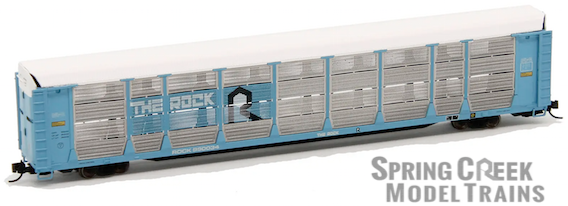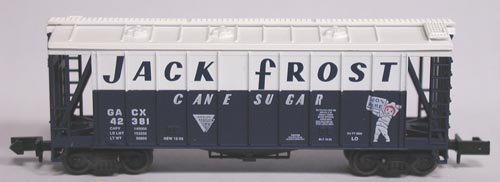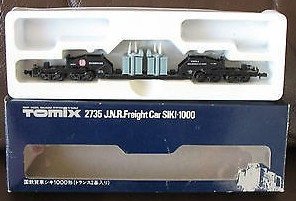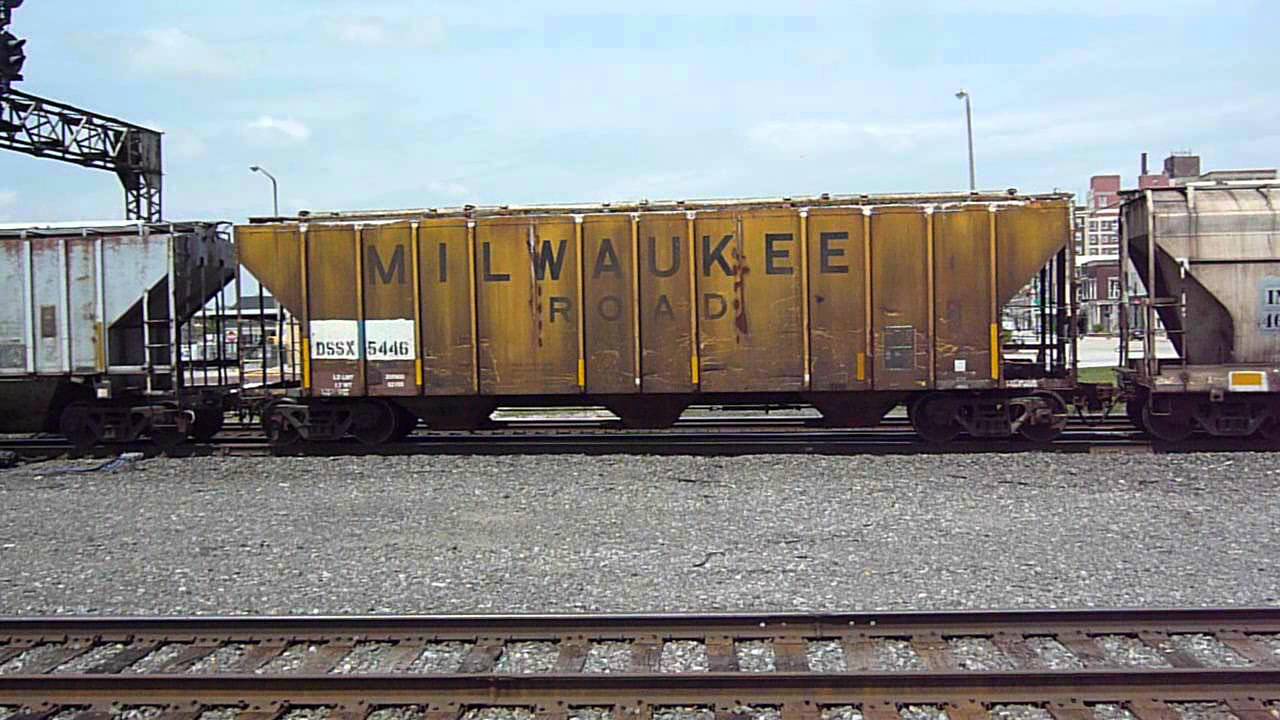Specific Item Information: BACHMANN MADE IN HONG KONG molded into bottom.
Model Information: Bachmann originally released this body style in 1968 and marketed it as a 47 Foot 70 Ton hopper. It was released in 6 different road names with the standard nickel-silver plated wheels and Rapido couplers. One product number 5499 lists the road name as "assorted". My guess is that means you can get any one of the 6 road names in this box. Later catalogs ONLY list the assorted version. Again, my guess is that Bachmann was having trouble keeping all 6 road names in stock at all times.
More recently this car has been updated with EZ-Mate II couplers and blackened metal wheels. The new releases are marketed as a "PS-2 Three Bay Covered Hoppers". With five hatches on each side, a center mounted roofwalk, 3 bays, ribs and the same brake wheel placement, it is clear that this is the same car as the earlier 47 Foot 70 Ton Covered Hopper. Whether a new mold was created is anybody's guess, but with the long lifespan of this body style, it is likely the mold has been redone more than once in the near 50 year lifetime of this tooling.
More recently this car has been updated with EZ-Mate II couplers and blackened metal wheels. The new releases are marketed as a "PS-2 Three Bay Covered Hoppers". With five hatches on each side, a center mounted roofwalk, 3 bays, ribs and the same brake wheel placement, it is clear that this is the same car as the earlier 47 Foot 70 Ton Covered Hopper. Whether a new mold was created is anybody's guess, but with the long lifespan of this body style, it is likely the mold has been redone more than once in the near 50 year lifetime of this tooling.
Prototype History: Like their PS-1 boxcars, PS-5 gondolas and other car designs, Pullman Standard applied the PS-2 classification to all of its covered hoppers. Pullman Standard built covered hoppers in many sizes and configurations. But say “PS-2” to railfans and it is this particular car that usually first comes to mind. The 2003 cubic foot car was one of the first, smallest and prolific of the PS-2 cars.
Pullman began building its standardized freight car designs with the PS-1 boxcar in 1947. Next up would be a standard covered hopper – hence PS-2 – shortly thereafter. Although covered hoppers are among the most common cars on the rails today, in 1947 they were a rarity. The PS-2’s primary competition wasn’t other covered hopper designs but boxcars. Grain, cement, sand and dried chemicals were carried mostly in boxcars prior to the 1950s either in sacks and bags or poured in bulk through hatches in the roof. The theory here was that it made more sense to utilize a single car for a variety of products. The car could carry bags of cement one way and then cut lumber the other. Of course a car that could do many things often couldn’t do many of them well.
Pullman began building its standardized freight car designs with the PS-1 boxcar in 1947. Next up would be a standard covered hopper – hence PS-2 – shortly thereafter. Although covered hoppers are among the most common cars on the rails today, in 1947 they were a rarity. The PS-2’s primary competition wasn’t other covered hopper designs but boxcars. Grain, cement, sand and dried chemicals were carried mostly in boxcars prior to the 1950s either in sacks and bags or poured in bulk through hatches in the roof. The theory here was that it made more sense to utilize a single car for a variety of products. The car could carry bags of cement one way and then cut lumber the other. Of course a car that could do many things often couldn’t do many of them well.
Road Name History:  Koppers is a global chemical and materials company based in Pittsburgh, Pennsylvania, United States in an art-deco 1920s skyscraper, the Koppers Tower.
Koppers is a global chemical and materials company based in Pittsburgh, Pennsylvania, United States in an art-deco 1920s skyscraper, the Koppers Tower.
In 1943, Koppers, at the US Government's behest, built a factory in Kobuta, Pennsylvania on the left bank of the Ohio River just downriver from Beaver, to manufacture styrene-butadiene monomer, a building block used to make a form of synthetic rubber for the World War II defense effort.
In 1951, at Port Arthur, Texas, the company built a plant to manufacture the chemical monomer ethylbenzene, using as raw materials ethylene from the nearby Gulf Oil refinery, and benzene, which was a byproduct of the company's coke ovens in Pennsylvania and which was shipped down to Texas by barge. The ethylbenzene produced there was then shipped by barge back up to the Kobuta plant where it was converted to styrene monomer, and then polymerized to make expandable polystyrene. In the early 1950s, the company purchased a license to manufacture polyethylene at its Port Arthur plant. These chemical operations later were the basis for forming a new corporate entity with Sinclair Oil Corporation to form the Sinclair-Koppers Company in 1965.
In early 1988 Beazer, a British conglomerate run by one of the foremost corporate raiders of the 1980s, successfully launched a hostile takeover of Koppers for $1.81 billion ($3.8 billion today). The sale was completed on June 17, 1988. A smaller, more streamlined domestic business unit of Koppers was bought back by local management in the early 2000s, and although much simpler than the once sprawling chemical and aggregate conglomerate of the early-to-mid 20th century, Koppers has once again become successful at its core businesses. In 2006 the new Beazer-free independent Koppers again went public.

In 1943, Koppers, at the US Government's behest, built a factory in Kobuta, Pennsylvania on the left bank of the Ohio River just downriver from Beaver, to manufacture styrene-butadiene monomer, a building block used to make a form of synthetic rubber for the World War II defense effort.
In 1951, at Port Arthur, Texas, the company built a plant to manufacture the chemical monomer ethylbenzene, using as raw materials ethylene from the nearby Gulf Oil refinery, and benzene, which was a byproduct of the company's coke ovens in Pennsylvania and which was shipped down to Texas by barge. The ethylbenzene produced there was then shipped by barge back up to the Kobuta plant where it was converted to styrene monomer, and then polymerized to make expandable polystyrene. In the early 1950s, the company purchased a license to manufacture polyethylene at its Port Arthur plant. These chemical operations later were the basis for forming a new corporate entity with Sinclair Oil Corporation to form the Sinclair-Koppers Company in 1965.
In early 1988 Beazer, a British conglomerate run by one of the foremost corporate raiders of the 1980s, successfully launched a hostile takeover of Koppers for $1.81 billion ($3.8 billion today). The sale was completed on June 17, 1988. A smaller, more streamlined domestic business unit of Koppers was bought back by local management in the early 2000s, and although much simpler than the once sprawling chemical and aggregate conglomerate of the early-to-mid 20th century, Koppers has once again become successful at its core businesses. In 2006 the new Beazer-free independent Koppers again went public.
Brand/Importer Information: Bachmann Industries (Bachmann Brothers, Inc.) is a Bermuda registered Chinese owned company, globally headquartered in Hong Kong; specializing in model railroading.
Founded in Philadelphia, Pennsylvania, the home of its North American headquarters, Bachmann is today part of the Kader group, who model products are made at a Chinese Government joint-venture plant in Dongguan, China. Bachmann's brand is the largest seller, in terms of volume, of model trains in the world. Bachmann primarily specializes in entry level train sets, and premium offerings in many scales. The Spectrum line is the high quality, model railroad product line, offered in N, HO, Large Scale, On30, and Williams O gauge all aimed for the hobbyist market. Bachmann is the producer of the famous railroad village product line known as "Plasticville." The turnover for Bachmann model trains for the year ended 31 December 2006 was approximately $46.87 million, a slight increase of 3.36% as compared to 2005.
Founded in Philadelphia, Pennsylvania, the home of its North American headquarters, Bachmann is today part of the Kader group, who model products are made at a Chinese Government joint-venture plant in Dongguan, China. Bachmann's brand is the largest seller, in terms of volume, of model trains in the world. Bachmann primarily specializes in entry level train sets, and premium offerings in many scales. The Spectrum line is the high quality, model railroad product line, offered in N, HO, Large Scale, On30, and Williams O gauge all aimed for the hobbyist market. Bachmann is the producer of the famous railroad village product line known as "Plasticville." The turnover for Bachmann model trains for the year ended 31 December 2006 was approximately $46.87 million, a slight increase of 3.36% as compared to 2005.
Item created by: gdm on 2016-12-05 09:48:39. Last edited by gdm on 2021-02-25 17:10:49
If you see errors or missing data in this entry, please feel free to log in and edit it. Anyone with a Gmail account can log in instantly.
If you see errors or missing data in this entry, please feel free to log in and edit it. Anyone with a Gmail account can log in instantly.










